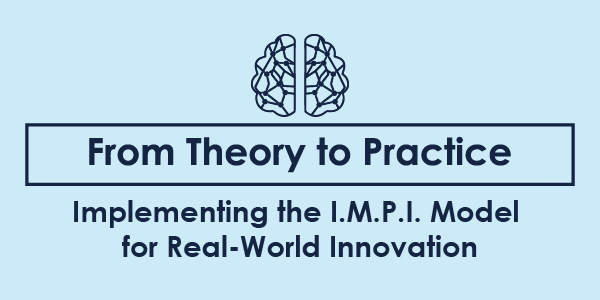Imagine you’re in a bustling office, surrounded by a team of creative minds, each buzzing with ideas ready to revolutionize your industry. Yet, despite the energy, there’s a challenge: how do you turn these brilliant concepts into actionable plans that lead to tangible results? This is where the I.M.P.I. Model by Joseph Ngala comes into play- a structured framework that guides organizations from the spark of inspiration to successful implementation.
What is the I.M.P.I. Model?
The I.M.P.I. The model is a step-by-step approach that helps organizations innovate effectively. It covers everything from developing ideas to making them happen in the real world.
1. Idea Generation: The Starting Point
It all begins with Idea Generation. This is when you brainstorm and explore new solutions to problems. Use group discussions, market research, and customer feedback to find fresh ideas.
Encourage everyone to share their thoughts. Involving people from different areas creates a space where creativity thrives, and new ideas come to life.
2. Model Development: Planning the Path
After you have a great idea, move to Model Development. This is where you create a detailed plan for how to make your idea real. Think of it as a roadmap showing every step needed to succeed.
Key parts include defining what the project will achieve, what resources you’ll need, and how you’ll reach your goals. A clear model keeps everyone aligned and focused.
3. Protocol Design: Setting the Rules
Next is Protocol Design, which involves setting up guidelines and procedures. Decide who does what set timelines, and establish how you’ll measure success.
Having clear protocols ensures everyone knows their role and helps avoid confusion during the project. It also helps manage risks and keeps the project on track.
4. Implementation Strategy: Making it Happen
Finally, you reach the Implementation Strategy. This is where you put your plan into action. It involves organizing resources, coordinating tasks, and keeping track of progress.
Stay flexible and ready to adapt. Monitor things, gather feedback, and make changes if needed. This approach helps overcome challenges and ensures success.
How to Use the I.M.P.I. Model in Real Life
Implementing the I.M.P.I. The model effectively involves a series of strategic steps. Here’s how to put each phase into practice:
1. Engage a Diverse Team
Diverse Perspectives: Involve team members from different departments and backgrounds. This diversity brings many ideas and solutions, enhancing creativity and innovation.
Foster Open Communication: Encourage an environment where everyone feels comfortable sharing their thoughts. Regular brainstorming sessions can help generate new ideas and refine existing ones.
Collaborate Across Levels: Engage employees at all levels, from entry-level staff to top management. Each group can offer unique insights that contribute to the innovation process.
2. Create a Detailed Plan
Define Clear Objectives: Outline what you aim to achieve with your innovation. Clear goals provide direction and help measure success.
Identify Resources: Determine the resources needed, such as personnel, technology, and budget. Ensure these resources are allocated effectively to support the project.
Develop an Implementation Roadmap: Create a step-by-step plan that details each phase of the project. This roadmap serves as a guide to keep the project on track.
Anticipate Challenges: Identify potential obstacles and develop strategies to address them. Being prepared helps minimize disruptions during the implementation.
3. Set Clear Guidelines
Establish Roles and Responsibilities: Clearly define who is responsible for each aspect of the project. This ensures accountability and smooth execution.
Set Timelines: Develop a timeline for each stage of the project. Setting deadlines helps maintain momentum and ensures timely completion.
Create Performance Metrics: Establish criteria to measure the success of the project. Regularly evaluate progress against these metrics to ensure objectives are met.
Outline Communication Protocols: Set up regular check-ins and updates to keep everyone informed. Effective communication is key to preventing misunderstandings and ensuring alignment.
4. Execute with Care
Mobilize Resources: Ensure all necessary resources are in place and ready to be utilized. This includes both human and material resources.
Coordinate Activities: Organize tasks efficiently to maximize productivity. Use project management tools to track progress and manage tasks effectively.
Monitor Progress: Regularly review the project’s progress against the set goals and timelines. This helps identify any deviations early and allows for timely corrections.
Adapt to Changes: Stay flexible and be ready to adjust strategies as needed. Adaptability is crucial for overcoming unforeseen challenges and ensuring the project’s success.
Gather Feedback: Continuously seek input from team members and stakeholders. Feedback provides valuable insights and can lead to improvements in the project.
Wrapping Up
he I.M.P.I. Model offers a systematic approach to innovation, enabling organizations to navigate the complexities of transforming ideas into tangible outcomes. By following this structured framework, businesses can enhance their ability to innovate, driving growth and competitive advantage in today’s rapidly evolving marketplace.
Incorporating the I.M.P.I. Model into your organization’s strategy not only streamlines the innovation process but also ensures that each step is meticulously planned and executed. This not only increases the likelihood of success but also fosters a culture of continuous improvement and adaptability.
Ultimately, the I.M.P.I. Model is more than just a theoretical framework; it’s a practical tool for turning visionary ideas into real-world success stories. By embracing this approach, organizations can unlock their full potential and lead the charge in their respective industries.

